Movie Review – Hobbit, The: The Desolation of Smaug
Rousing spectacle overrides many – but not all – of the flaws encountered in the previous instalment; Desolation is a more adventurous and epic film in many respects, delivering earth-shaking action with Smaug, some minor humor with the dwarves, and setting up the climactic third film to come. Desolation Of Smaug has a number of memorable moments, and will undoubtedly be a cracker on BluRay in years to come, and even though one can still argue for Jackson throwing in all available material into this relatively simple story, he stages the prodoction magnificently, papering over any flaws with dynamite film style and an adherence to one crucial blockbuster rule: keep people entertained.
– Summary –
Director : Peter Jackson
Year Of Release : 2013
Principal Cast : Martin Freeman, Ian McKellan, Richard Armitage, Benedict Cumberbatch, Orlando Bloom, Evangeline Lily, Luke Evans, Stephen Fry, Lee Pace, Graham McTavish, Ken Stott, Aidan Turner, Dean O’Gorman, Mark Hadlow, Jed Brophy, Adam Brown, John Callen, Peter Hambleton, William Kircher, James Nesbitt, Stephen Hunter, Mikael Persbrandt, Sylvester McCoy, Craig Hall, Ryan Gage, Manu Bennett.
Approx Running Time : 161 Minutes
Synopsis: Bilbo and his Dwarf company continue their trek across Middle-Earth, on their way to the Lonely Mountain, where they must confront Smaug to return the stolen treasure of Erebor, and Thorin’s rightful claim to the throne. Gandalf, meanwhile, stirs up trouble elsewhere, as a nameless darkness begins to surface throughout the dark corners of the land.
What we think : Rousing spectacle overrides many – but not all – of the flaws encountered in the previous instalment; Desolation is a more adventurous and epic film in many respects, delivering earth-shaking action with Smaug, some minor humor with the dwarves, and setting up the climactic third film to come. Desolation Of Smaug has a number of memorable moments, and will undoubtedly be a cracker on BluRay in years to come, and even though one can still argue for Jackson throwing in all available material into this relatively simple story, he stages the production magnificently, papering over any flaws with dynamite film style and an adherence to one crucial blockbuster rule: keep people entertained.
**********************
Forget the book. This is entertainment.
As a long time Tolkein fan, I was among those who were underwhelmed by Peter Jackson’s first visit back to Middle-Earth, in The Hobbit: An Unexpected Journey. I felt it to be somewhat bloated, an utter drag during its opening Bag-End-bound act, and seemed to misstep when it should be striding confidently back into the world of orcs and Dwarves. Debate continues to rage (and probably always will) about Jackson and Warner Bros’ decision to split the already thinly plotted original text into three gargantuan films, about whether adding in material from Tolkein’s Rings appendices was a good idea [Vivek over at The Cinematic Katzenjammer seems to think it should be], about whether it was greedy to add another three-hour film into the mix of an already thin story; The Desolation of Smaug needed to be the film that stopped such chatter. Jackson’s missteps in the previous film had to be shored up here, as Bilbo and his dwarven accomplices make their way to The Lonely Mountain; the confrontation with one of Tolkein’s most vivid characters, Smaug needed to elevate Desolation a lot more than the scrotum-faced Golbin King elevated Journey. So is The Desolation of Smaug a problematic middle-film, and does it manage to push aside the fears of those who thought The Hobbit’s dearth of plot might come back to haunt this ambitious film project? Is this Desolation the Middle-Earth equivalent of scorched earth film-making?
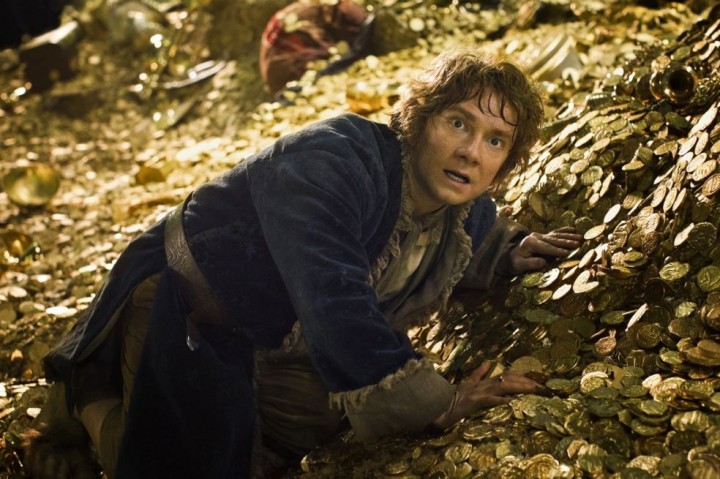
Synopsis courtesy Wikipedia: Bilbo (Martin Freeman) along with Gandalf (Ian McKellan) and Thorin Oakenshield (Richard Armitage) and his twelve companions, leave the Carrock after the events of the previous film. They continue east to the edge of the forest of Mirkwood where they encounter the skin-changer Beorn (Mikael Persbrandt). Gandalf departs before the others enter Mirkwood where they are attacked by giant spiders and, except for Bilbo, are captured by Wood-elves. Bilbo helps the dwarves escape from the elves and they follow the forest river to Lake-town, where they meet the Master of the town (Stephen Fry), and Bard (Luke Evans), a bowman and the descendant of the original Lord of Dale. After acquiring a boat and supplies from the town, the company travels to the Lonely Mountain. They eventually find the hidden door into the mountain, where Bilbo enters and encounters the dragon Smaug (Benedict Cumberbatch). In the meantime, Gandalf leads the White Council to drive the Necromancer out of Dol Guldur. Gandalf enters Dol Guldur, where he discovers the true identity of the Necromancer. The elves of Mirkwood, led by King Thranduil (Lee Pace) and his son, Legolas (Orlando Bloom), must battle the orc invasions from Dol Guldur.
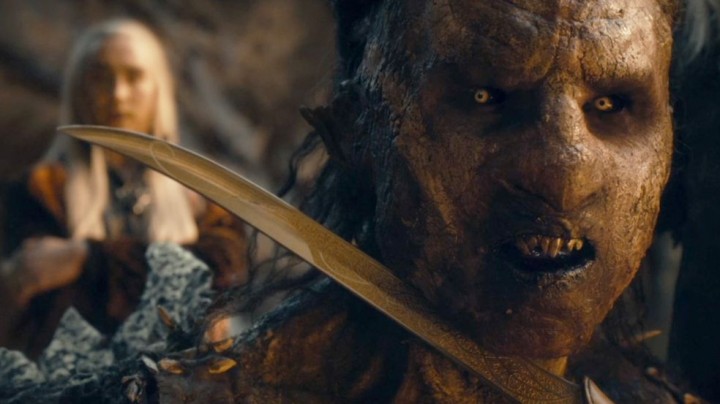
One of the things Peter Jackson mentions in his Extended Unexpected Journey appendices is how the failings of the first film, and criticism surrounding much of his decision making, drove him to focus more tightly on The Desolation Of Smaug, to make it the best possible film it could be. Where Unexpected Journey was a little flabby around the middle, a problem due to having to set-up the characters and reintroduce the world of Middle Earth, as well as set up the major story arc of recovering the dwarven Arkenstone, The Desolation Of Smaug launches right into the action from the get go. Jackson’s assured film-making style is evident in every frame, with smaller, more intimate character beats interspersed between some dynamite action sequences, none the least is the third act of the film in which Smaug, the titular dragon of the film, strides like a CG colossus over proceedings and – in a weird twist somewhat apropos for a Middle Earth film – overshadows his fellow cast much like Gollum did in the original Rings trilogy.
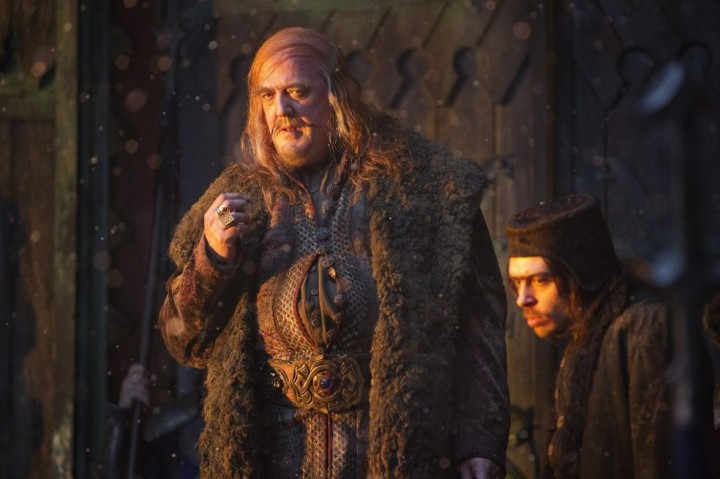
While the film is indeed a better one than its predecessor, Desolation still has some of the same flaws running through it – no doubt a byproduct of the trilogy being filmed as one shooting block: namely, a large amount of exposition that still feels extraneous, almost unnecessary, even though a lot of it helps build the world through which Bilbo, Thorin, Gandalf and the company of dwarves move. Extensive sequences in Mirkwood’s Elvish kingdom, with King Thranduil having Denethor-like blind-eye complex to the world around him, remove some of the focus from Bilbo and the quest to reclaim Erebor (the lost home of the dwarves, now claimed by the dragon Smaug), while Jackson spends a lot of time with Luke Evans’ Bard and his family, setting up a hitherto unknown payoff in There And Back Again. A lot of the extra material in Desolation hints at events in TABA, to the point where it becomes somewhat distracting. I’m all for laying groundwork, sure, but when it becomes detrimental to the film we’re current enjoying, that’s when I find fault. Desolation is a magnificently mounted epic, and Jackson’s grand vision is enviably intricate, yet once again the ugly cry of bloating out a thin source text to three three-hour films rears its head. Admittedly, there’s plenty of fun to be found in Desolation, and what faults there are are somewhat mitigated by the improved pacing and relative lack of obvious padding, yet at 160 minutes, it still feels a little too long.
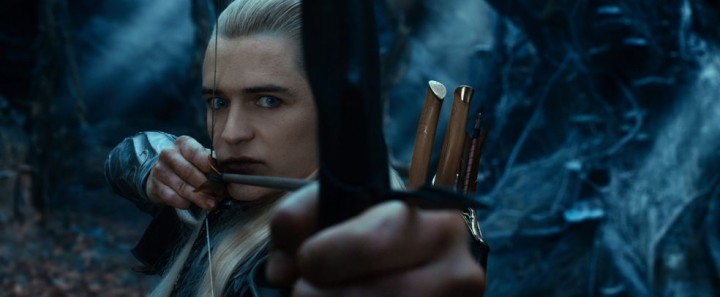
Desolation’s major set-pieces are truly epic. The film’s opening chase through Mirkwood by Azog and his band of orcs – sent from Dol Guldur by the “Necromancer”, who turns out to be none other than a protoform of Sauron (another of the film’s stunning action moments, in which Gandalf infiltrates Dol Guldur, reveals this to us, in most thunderous fashion, is a moment I cannot wait to get home on BluRay and crank up to 11) – as well as a subsequent encounter with both Beorn (a creepy looking Mikael Persbrandt) and the forest’s resident Shelob-style spiders (which is genuinely icky, for sure), set up the action to come. However, the film sinks to a crawl as the dwarf company are captured by Mirkwood Elves, led by Rings combatant Legolas (a returning, and somewhat chunkier, Orlando Bloom), and ruled by the less-than-friendly Thranduil. The film deviates from Tolkein’s text by introducing a completely invented character, Tauriel, in the form of Evangeline Lily, setting up a three-way love arc between the she-elf, Legolas and one of the dwarves, Kili (Aidan Turner). I had a problem with this romantic entanglement, in that it was rather contrived and – unlike a similar dwarf-elf motif in Rings, between Gimli and Galadriel (Cate Blanchett appears for about two frames in this film, allowing her name to be mentioned in the credits) – hokey. Once Bilbo rescues the dwarves from Elvish captivity, by way of a staggeringly mounted barrels-down-a-river sequence, we end up in Laketown, under the guardianship of Bard, and the film rounds down to another slow point, invariably introducing more characters and setting up the events of There And Back Again.
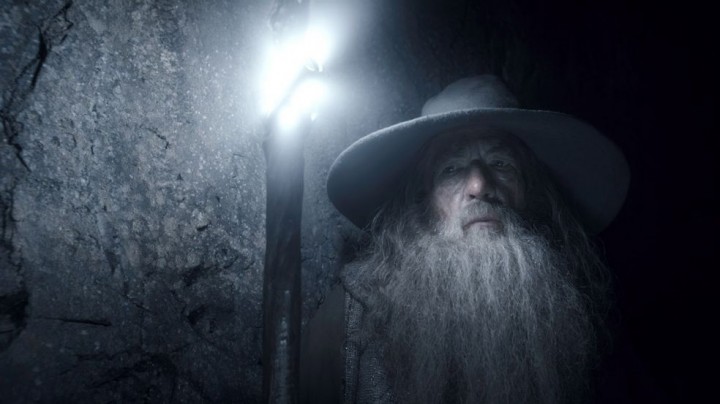
The entire third act of the film is used to bring us what we all have waited a lifetime to see – Smaug, larger than life, up on the big screen, and Jackson doesn’t disappoint. Smaug is easily one of literature’s great villains, and a dragon no less, and his digital magnificence puts Dragonheart and Eragon in the shade for intricacy and detail. With motion capture and (awe-some) voice performance by Benedict Cumberbatch (Sherlock, Star Trek Into Darkness), Smaug is a seething, sly, powerfully arrogant beast that invariably cannot physically fit onto the screen. He’s the star of the film, and once he appears in full form, from out beneath the enormous mountain of gold and jewels hidden beneath the Lonely Mountain, Jackson makes the most of his interactions with Bilbo, and then with the dwarves who engage Smaug in a dangerous cat-and-mouse pursuit that ends with the flying lizard loosing from his lair and heading towards Laketown. Jackson understands epic sequences, and the entirety of the Smaug-driven third-act epitomizes that, a lot like the ape/T-rex battle in 2005’s King Kong. It’s worth the price of admission just to see Cumberbatch’s Smaug. I could listen to that voice all damn day.
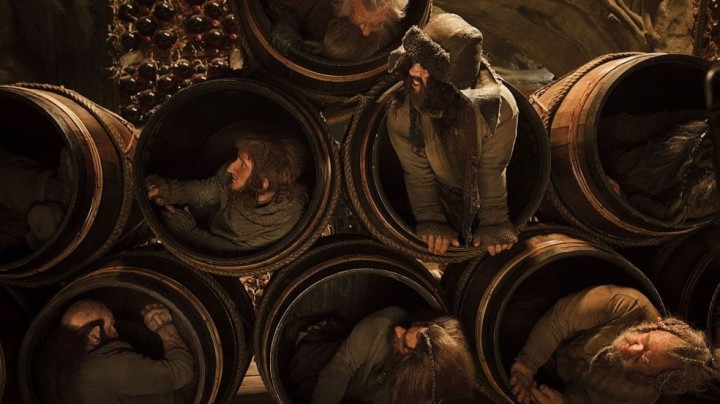
While Smaug might command the film’s finale, and indeed the very title of this opus, the primary humanoid villain is Azog (Kiwi Manu Bennett), who was introduced in Unexpected Journey, and who takes things up a notch here as he and his Orcs pursue the dwarves right into Laketown’s inner sanctum. Azog’s son, Bolg (Lawrence Makoare) is also involved, a duo of danger that remains constant throughout Desolation’s running time, and no doubt will have a bearing on the third film’s crucial tragic ending (I won’t spoil what’s to come for those who haven’t read the books). Azog and Bolg are potent enemies, even if their motivations and character arcs reside purely in snarling and wanton violence. They exist to drive our heroes, all fourteen of them (Gandalf goes off on a search for clues to the nature of the Necromancer/Sauron, and has little to do directly with the dwarves once they enter Mirkwood) further towards their goal, that of scaling the Lonely Mountain and reclaiming Erebor. Jackson skilfully navigates the story between Bilbo and Thorin’s journey, and Azogs hound-dog pursuit of his quarry, although it becomes less about character and more about massive combat sequences, as Legolas and Tauriel follow along to act as surrogate protectors of the dwarves from their pursuers.
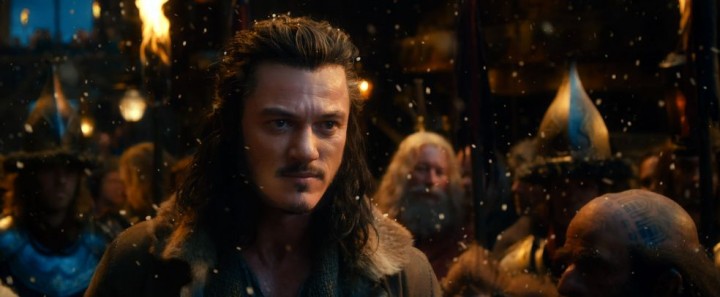
One of the things I could see Jackson trying to highlight through Desolation’s final act, and something I can see being crucial in the third film, is Thorin’s drive and almost manic desire to retrieve the Arkenstone and reclaim Erebor. The effect this journey and his quest has on him is almost parallel to the One Ring’s pull over all who possess it. Thorin is even reprimanded at one point for becoming almost cruel in his treatment of the Company – especially Bilbo – for his own ends. It’s a story facet I didn’t think was that well developed here, mainly because Jackson doesn’t earn the dramatic weight of this moment throughout the majority of the film, but I could see what he was trying to do even as it didn’t work.
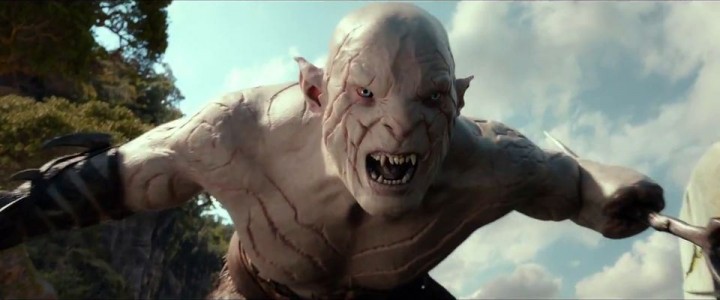
Another element I thought was a little ill-fitting in Desolation’s rather dark trajectory was Bard’s family situation, as well as the Laketown political scene. Obviously Laketown and Bard play pivotal roles in further events the Hobbit trilogy will reveal, but within the framework of Desolation, it just seemed to stall the story right when things were getting to the sharp end. I like Luke Evans, and Bard is somewhat analogous to Rings’ Faramir, but I felt the shift of focus to his rebellious antics and Han Solo-esque attitude to the settlement’s garrulous “mayor”, Master (a deliciously sly Stephen Fry, aided by a rather Wormtongue-like Ryan Gage as his underling, Alfrid), detracted from the story I wanted to see, that of Bilbo, Thorin, and Smaug. A sidebar plot involving Kili being struck by an arrow and poisoned, and having to be rescued by Tauriel, doesn’t feel very Tolkien-y, and that’s as blatant as I can get in saying that it doesn’t work. Some of Tolkein’s more literary moments become lost in Jackson’s revisionist creationism – Bilbo’s verbal sparring with Smaug lacks the witty subtlety the author injected into Smaug’s personality, while Bilbo’s decision to flatter Smaug is equally baffling as it appears to come from nowhere (it’s in the book, it just isn’t earned within the context of the film) – and I just felt a little let down by my personal expectations not being met. Which is more my problem, not Jackson’s.
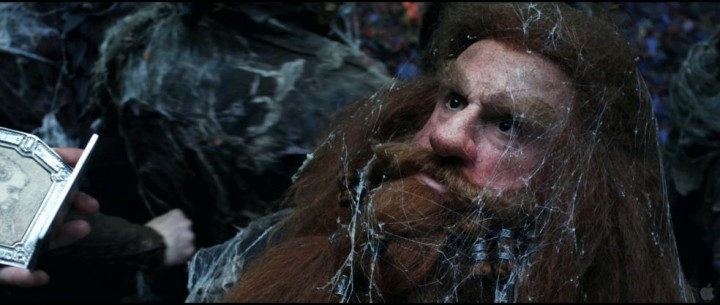
I’ve already mentioned the wonderful moment Gandalf uncovers the truth behind the Necromancer’s identity, as well as Smaug’s inevitably iconic appearance in the final act (I cannot overstate how magnificent this entire sequence is, with Bilbo trading verbal blows with the malevolent serpent in a nightmarish underground setting, all but equaling the Balrog sequence from Fellowship Of The Ring), but I’ve neglected to really iterate two key sequences in the film; the spider battle in Mirkwood, and the Barrels Out Of Bond sequence involving all the dwarves careening down river rapids, escaping their Orc pursuers. The spider sequence is surprisingly free from ostentation, coming up rather abruptly within the narrative and lasting a good fifteen minutes, with the dwarves all wrapped in webbing leaving Bilbo (and his Ring) to save the day. The spiders are convincing, well realized digital creations, creepy, disgusting creatures that deliver appropriate audience freak-out moments and provide some nice character moments for Bilbo. The Barrels sequence is one of the most viscerally entertaining-for-its-own-sake moments in the entire Hobbit franchise thus far (from an action/adventure perspective, at least) and delivers one of the film’s most amusing moments, thanks to Bombur’s girth once again providing some slight humor.
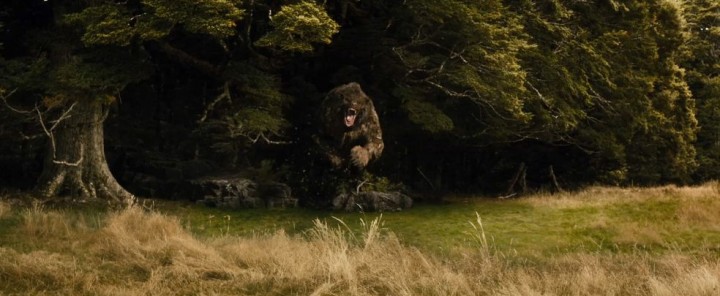
As much as there is to find fault with Desolation’s still-bloated adventure, there’s more to love than loathe. In amongst the foundational mythology-building work Jackson is doing, beats a passion and desire to bring Tolkein’s world to life in the most brilliant way possible. Nobody knows this cinematic world better than Jackson, and there’s a gleeful joy in watching him work his magic throughout the film’s ups and downs. Sure, just because he’s passionate doesn’t mean the film is by any means perfect, and God knows the Extended version will only exacerbate the problems the film has with length and tight pacing, but there’s magic at work in Desolation Of Smaug’s continuation of The Hobbit’s relatively thin plotting. The warm comfort of sliding back into Middle Earth almost allows for any faults to be skipped over, yet one can’t help but wonder what might have been had Jackson really taken the cutting knife to the three-film project, slicing all but the most important stuff out for theatrical release.
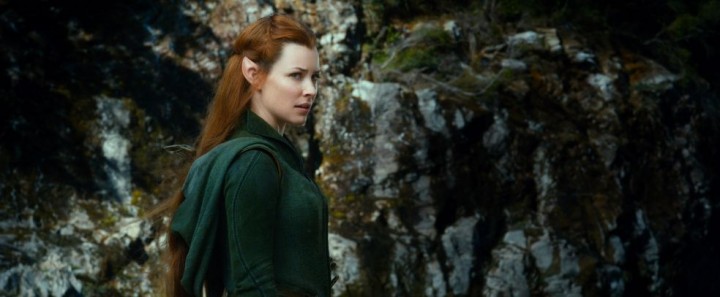
The Desolation Of Smaug may not be the perfect adventure film, but it is a significant improvement over Unexpected Journey. It hits some dull spots, has moments of confusing tonal shift, and splits itself in two trying to accommodate all the plot threads Jackson feels required to dangle in front of us, but a rousing dragon-featured final act, some clever action sequences and the sheer beauty of New Zealand’s crisp, unmistakeable landscape, (as well as Howard Shore’s still-gorgeous orchestral scoring) ensure Desolation is thoroughly enjoyable, if not entirely magnificent. The scene is set for a rousing closing chapter, with Smaug sliding through the air towards Laketown, and the threat of impending war hanging over the realm of Middle Earth – yes, we’re going to see the Battle of Five Armies in There And Back Again – so I expect Desolation will be a film I’ll return to time and again, if for nothing else but to see that fabulous dragon do its stuff.


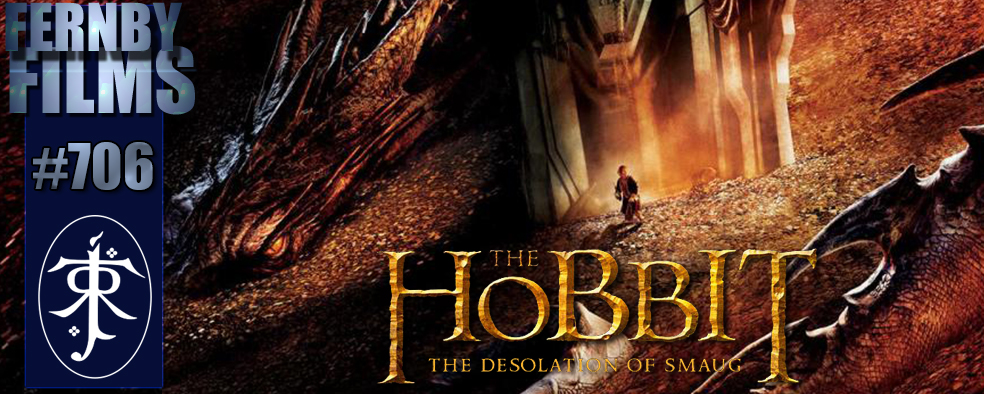







 The Hobbit: The Desolation of Smaug
The Hobbit: The Desolation of Smaug

[polldaddy 7681044 http://answers.polldaddy.com/poll/7681044/ polldaddy]
Glad you enjoyed this too, Rodney! I had a great time w/ this one as well. I particularly liked Thorin and the way Richard Armitage portrayed him, but the cast really is top notch! "It’s worth the price of admission just to see Cumberbatch’s Smaug" I concur! That's perfect casting right there! Can't wait for the final film, boy when I saw Smaug flying off to Lake-town, I wish the film just kept on going.
My recent post FlixChatter Review: The Wolf of Wall Street
Ha ha, you and most people, Ruth, hoped to see Smaug smash into Laketown, but I guess Jackson had a cliffhanger in mind!! I didn't mind it, to be honest, because it at least gives us something (else) to look forward to in There And Back Again! Armitage does a great job as Thorin, but for some reason I just felt the role was a little too forced as far as where they were trying to take the character. They kept trying to take him in the same direction as Frodo in LOTR, in that he's slowly being driven crazy by the treasure hidden in Erebor, and as I mentioned in my review, the moments Thorin has to struggle with his emotions – it wasn't earned, IMO.
Glad you liked it, Ruth!!